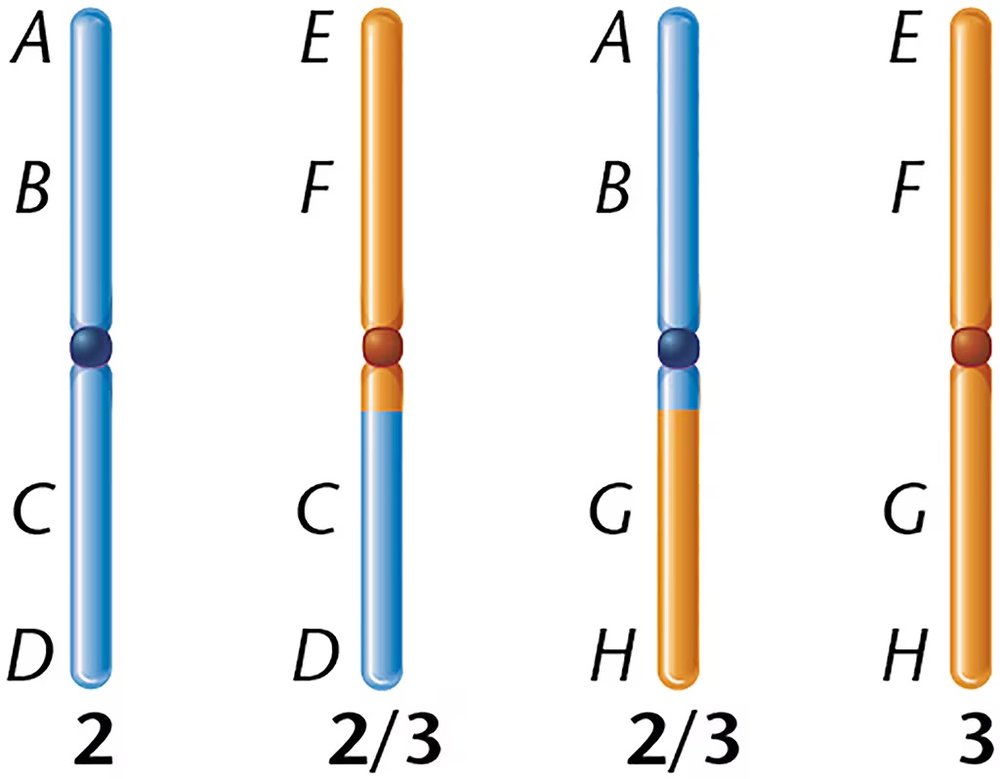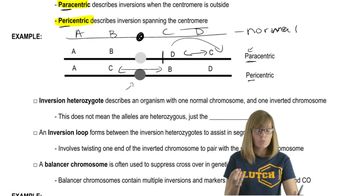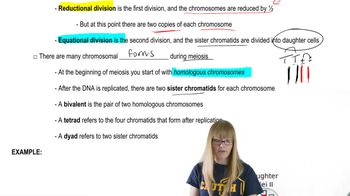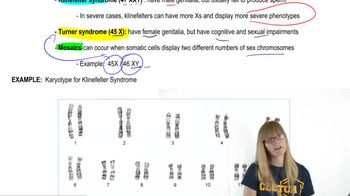Table of contents
- 1. Introduction to Genetics51m
- 2. Mendel's Laws of Inheritance3h 37m
- 3. Extensions to Mendelian Inheritance2h 41m
- 4. Genetic Mapping and Linkage2h 28m
- 5. Genetics of Bacteria and Viruses1h 21m
- 6. Chromosomal Variation1h 48m
- 7. DNA and Chromosome Structure56m
- 8. DNA Replication1h 10m
- 9. Mitosis and Meiosis1h 34m
- 10. Transcription1h 0m
- 11. Translation58m
- 12. Gene Regulation in Prokaryotes1h 19m
- 13. Gene Regulation in Eukaryotes44m
- 14. Genetic Control of Development44m
- 15. Genomes and Genomics1h 50m
- 16. Transposable Elements47m
- 17. Mutation, Repair, and Recombination1h 6m
- 18. Molecular Genetic Tools19m
- 19. Cancer Genetics29m
- 20. Quantitative Genetics1h 26m
- 21. Population Genetics50m
- 22. Evolutionary Genetics29m
9. Mitosis and Meiosis
Meiosis
Problem 24b
Textbook Question
A woman who sought genetic counseling is found to be heterozygous for a chromosomal rearrangement between the second and third chromosomes. Her chromosomes, compared to those in a normal karyotype, are diagrammed to the right.

Using a drawing, demonstrate how these chromosomes would pair during meiosis. Be sure to label the different segments of the chromosomes.
 Verified step by step guidance
Verified step by step guidance1
Understand the problem: The woman is heterozygous for a chromosomal rearrangement between the second and third chromosomes. This means one of her chromosome pairs has undergone a structural change, such as a translocation, inversion, or other rearrangement, while the homologous chromosome remains normal. During meiosis, homologous chromosomes must pair, even if their structures differ.
Identify the type of chromosomal rearrangement: Determine whether the rearrangement is a translocation (exchange of segments between non-homologous chromosomes), inversion (reversal of a segment within a chromosome), or another type. This will influence how the chromosomes align during meiosis.
Draw the chromosomes: Represent the normal and rearranged chromosomes. Label the segments of the chromosomes (e.g., A, B, C for chromosome 2 and X, Y, Z for chromosome 3). Clearly indicate the rearranged segments on the affected chromosomes.
Illustrate pairing during meiosis: Show how the homologous chromosomes align during prophase I of meiosis. For example, if the rearrangement is a translocation, the chromosomes may form a cross-shaped or quadrivalent structure to allow homologous regions to pair. Label the segments to show how they align.
Explain the consequences: Discuss how the pairing structure might affect gamete formation. For example, misalignment or improper segregation during meiosis could lead to unbalanced gametes, potentially causing fertility issues or genetic disorders in offspring.
 Verified video answer for a similar problem:
Verified video answer for a similar problem:This video solution was recommended by our tutors as helpful for the problem above
Video duration:
1mPlay a video:
Was this helpful?
Key Concepts
Here are the essential concepts you must grasp in order to answer the question correctly.
Heterozygosity
Heterozygosity refers to the presence of two different alleles at a specific locus on homologous chromosomes. In the context of genetic counseling, a heterozygous individual may carry one normal allele and one mutated or rearranged allele, which can influence genetic traits and the risk of passing on genetic disorders to offspring.
Recommended video:
Guided course

Inversions
Meiosis
Meiosis is a specialized type of cell division that reduces the chromosome number by half, resulting in the formation of gametes (sperm and eggs). During meiosis, homologous chromosomes pair up and exchange genetic material through a process called crossing over, which is crucial for genetic diversity. Understanding how chromosomes pair during meiosis is essential for visualizing the impact of chromosomal rearrangements.
Recommended video:
Guided course

Meiosis Overview
Karyotype
A karyotype is a visual representation of an individual's chromosomes, organized by size, shape, and number. It is used to identify chromosomal abnormalities, such as rearrangements, duplications, or deletions. In this scenario, comparing the woman's karyotype to a normal karyotype helps to illustrate the specific chromosomal changes that may affect meiosis and genetic inheritance.
Recommended video:
Guided course

Human Sex Chromosomes
Related Videos
Related Practice
Textbook Question
Given the end results of the two types of division, why is it necessary for homologs to pair during meiosis and not desirable for them to pair during mitosis?
374
views


